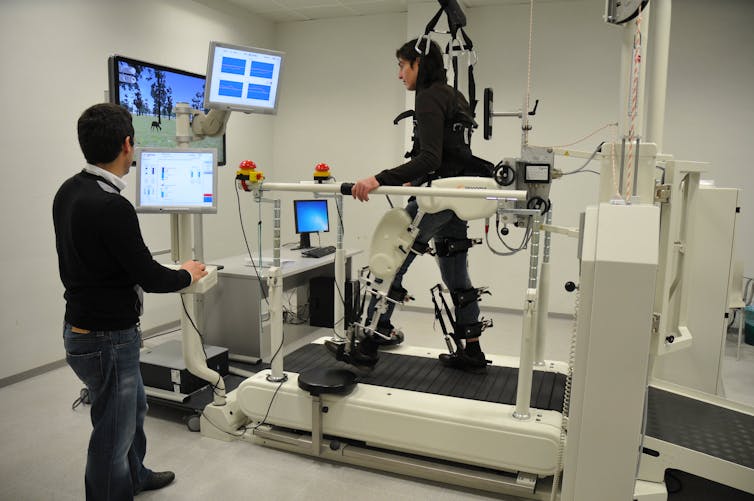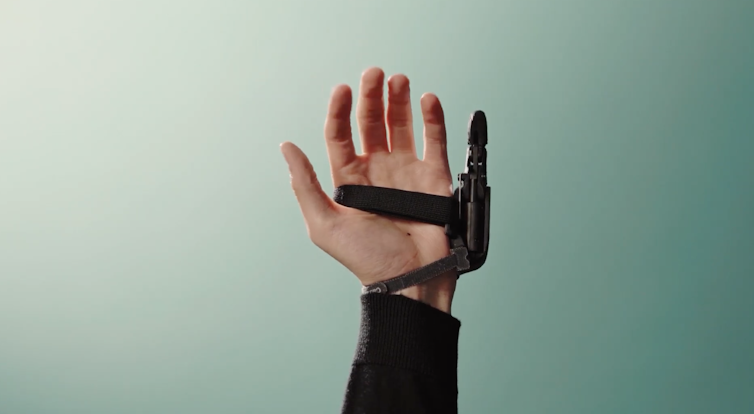Robots becoming ever closer to humans
Our society is changing. More and more, we're welcoming a new species into our midst. Robots.
Developing human-robot interactions is not just a robotic challenge, but also one of understanding humans and human society: how humans perceive robots, communicate with them, behave around them and accept (or not) them. This becomes all the more important with the arrival of the fourth generation of robots, which integrate directly into the human body.
Ganesh Gowrishankar, University of Montpellier

We're working to better understand what we call the "embodiment" of these devices: as these robots become "one" with us, they modify our behaviors and our brains.
The first generation of human-robot interactions for industry
This "time travel" of robots, from dangerous machines to an integral part of human society, has been going on for over forty years.
Robots are very diverse, in terms of their size(micrometric or even nanometric on the one hand, but human-sized or larger on the other), the way they move and their functionalities (industrial, space, defense, for example). Here, I'm not focusing on the robots themselves, but on the interactions between humans and robots, which I believe have developed over four generations.

Large-scale human-robot interaction began with the arrival of industrial robots, the first of which was introduced by General Motors in 1961. These slowly spread, and by the early 1980s, industrial robots were present in the USA, Europe and Japan.
These industrial robots have enabled us to observe the first generation of human-robot interactions: they generally operate within delimited zones, to ensure that humans don't approach them, even by mistake.
Industrial robots, which were first popularized by automotive assembly tasks, are now used for a variety of tasks, such as welding, painting, assembly, disassembly, pick and place for printed circuit boards, packaging and labeling.

Working side by side
Robotics research during this period focused on bringing robots and humans closer together, resulting in a second generation of human-robot interactions, materialized for the general public in the early 2000s, when machines like the Roomba and Aibo began to enter our homes.
These second-generation robots work in close proximity to humans in our homes and offices for "service applications", such as cleaning floors, mowing lawns and cleaning swimming pools - a market worth around US$13 billion in 2019. In 2009, there were around 1.3 million service robots worldwide; a number that had risen to around 32 million by 2020.
However, although these robots operate in a more human-like environment than industrial robots, they still interact in a fairly minimal and basic way. Most of their daily tasks are independent ones, requiring little interaction. In fact, they often even try toavoid interaction with humans - which is not always easy.
Interacting with humans
The relationship between humans and robots is now gradually evolving towards the third generation of interaction. Third-generation robots have the capacity to interact cognitively or socially, like so-called "social" robots, but also physically, like exoskeletons.

Robots capable of physical assistance, which could be used for rehabilitation and care of the elderly, social assistance and security, have also been clearly identified as a priority by governments in Europe, the USA and Japan since the mid-2010s.
This is one way of responding to the problem of ageing populations in these developed countries.
Challenging the definition of the human body
We are now slowly seeing the emergence of a fourth generation of human-robot interactions, in which robots are not just physically close to humans, but connected to the human body itself. Robots become extensions of the human body.
These include functional augmentation devices - such as supernumerary robotic limbs - and functional replacement devices such as robot avatars (which allow humans to use a robot body to perform specific tasks). Other devices can also provide additional sensory perception for humans.

Fourth-generation interactions are fundamentally different from other generations because of one crucial factor: before this generation, human and robot are clearly defined in all their interactions by the physical limits of their respective bodies, but this boundary becomes blurred in fourth-generation interactions, where robots modify and extend the human body in terms of motor and sensory capabilities.
In particular, fourth-generation interactions are expected to interfere with these "body representations". We know that there are specific representations of our body in our brain that define how our brain recognizes our body. These representations determine our cognition and behavior.
For example, imagine you're shopping in a crowded grocery aisle. As you reach for items with your right hand, you are able, very implicitly and without even realizing it, to avoid your left arm colliding with other shoppers.
This is possible because your brain has a representation of the size and shape of your limbs, and is aware of and monitors each of your limbs. If you're holding a basket in your arm (which changes the size and shape of the "arm"), you'll find it harder to instinctively avoid collisions, and will have to make a conscious effort to ensure that the basket doesn't hit anything in your immediate surroundings.
Similarly, can our brain adapt to a supernumerary limb, or other fourth-generation robotic addition, and update its bodily representations? This is what we call "embodiment" in neuroscience.
If these devices can be incarnated, how quickly? What are the limits of this incarnation? How does this affect our behavior and the brain itself?
Fourth-generation human-robot interactions not only call into question the acceptance of the machine by the user's brain, but also the user's acceptance in society: we still don't know whether our society will accept, for example, individuals with extra robotic arms. This will certainly depend on cultural aspects, which we are also trying to analyze.
In fact, third- and fourth-generation robots are so close to humans that we need to better understand human behavior and our brains to develop them.
In our work, we therefore combine robotics research with cognitive, motor and social neuroscience, to develop what we believe to be the science of human-machine interaction.
It is only through a holistic understanding of human individuals, the machines that interact with them and the society in which they live, that we will be able to develop future generations of robots. And, in a sense, the society of the future.
Ganesh Gowrishankar, Researcher at the Montpellier Laboratory of Computer Science, Robotics and Microelectronics, University of Montpellier
This article is republished from The Conversation under a Creative Commons license. Read theoriginal article.